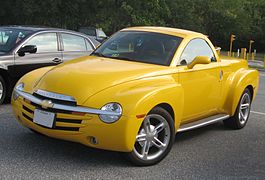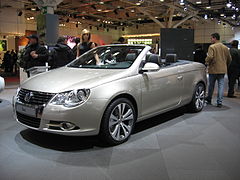Retractable hardtop

A retractable hardtop — also known as "coupé convertible" or "coupé cabriolet" — is a car with an automatically operated, self-storing hardtop, as opposed to the folding textile-based roof used by traditional convertible cars.
The benefits of improved climate control and security are traded off against increased mechanical complexity, cost, weight and often reduced luggage capacity.
A 2006 New York Times article suggested the retractable hardtop may herald the demise of the textile-roofed convertible,[1] and a 2007 Wall Street Journal article suggested "more and more convertibles are eschewing soft cloth tops in favor of sophisticated folding metal roofs, making them practical in all climates, year-round."[2]
History

1919 Ben P. Ellerbeck conceived a retractable hardtop – a manually operated system on a Hudson coupe that allowed unimpeded use of the rumble seat even with the top down[3] – but never saw production.[4]

1934 Lancia introduced the first production, power-operated retractable hardtop in 1934, the Belna Eclipse,[5][6][7] designed and patented by Georges Paulin.[1] The Belna was a French-built Lancia Augusta. The French coachbuilder, Marcel Pourtout, custom-built examples of Paulin's designs on other makes like Panhard and Peugeot 401, 402 or 601.[1]
1941 Chrysler introduced a retractable hardtop concept car, the Chrysler Thunderbolt.[3]
1947 American Playboy Automobile Company marketed one of the first series produced convertibles, with a retractable roof consisting of more than one section. Ninety-seven production models were made, until their bankruptcy in 1951.


1953 Ford Motor Company spent an estimated US$2 million (US$22,776,119 in 2023 dollars[8]) to engineer a Continental Mark II with a servo-operated retractable roof. The project was headed by Ben Smith, a 30-year-old draftsman.[9] The concept was rejected for cost and marketing reasons.[3] Engineering work was recycled to the Ford Division which used the retractable mechanism in their 1957-1959 flagship Ford Fairlane 500 Skyliner after an estimated US$18 million (US$195,270,142 in 2023 dollars[8]) more was spent.[10]
1955 Brothers Ed and Jim Gaylord showed their first prototype at the 1955 Paris motor show,[11] but the car failed to reach production.
1957 Ford introduced the Fairlane 500 Skyliner in the United States. A total of 48,394 were built from 1957 to 1959.[3] The retractable top was noted for its complexity and usually decent reliability[12][13] in the pre-transistor era. Its mechanism contained 10 power relays, 10 limit switches, four lock motors, three drive motors, eight circuit breakers, as well as 610 feet (190 m) of electrical wire,[3] and could raise or lower the top in about 40 seconds. The Skyliner was a halo car with little luggage space (i.e., practicality), and cost twice that of a baseline Ford sedan.
1989 Toyota introduced a modern retractable hardtop, the MZ20 Soarer Aerocabin. The car featured an electric folding hardtop and was marketed as a 2-seater with a cargo area behind the front seats. Production was 500 units.

1995 The Mitsubishi GTO Spyder by ASC was marketed in the U.S.[4] The design was further popularized by such cars as the 1996 Mercedes-Benz SLK.[1] and 2001 Peugeot 206 CC.
2006 Peugeot presented a concept four-door retractable hardtop convertible, the Peugeot 407 Macarena.[14] Produced by French coachbuilding specialist Heuliez, the Macarena's top can be folded in about 30 seconds.[14] It has a reinforcing beam behind the front seats which incorporates LCD screens into the crossmember for the rear passengers.[14]
Construction

Retractable hardtops are commonly made from between two and five sections of metal or plastic and often rely on complex dual-hinged trunk/boot lids that enable the trunk lid to both receive the retracting top from the front and also receive parcels or luggage from the rear. The trunk also often includes a divider mechanism to prevent loading of luggage that would conflict with the operation of the hardtop.
Variations
- The Volkswagen Eos features a five-segment retractable roof where one section is itself an independently sliding transparent sunroof.[2]
- The Mercedes SL hardtop features a glass section that rotates during retraction to provide a more compact "stack."
- The third-generation Mazda MX-5 was available with an optional power retractable hardtop, in lieu of the standard folding-textile soft-top. Compared to the regular soft-top, the hardtop weighed 77 lb (35 kg) more yet had no reduction in cargo capacity.[15] The MX-5 was one of the few cars offering both hardtop and soft-top convertible choices. The hardtop roof was constructed of polycarbonate and manufactured by the German firm Webasto.[16]
- The Chrysler Sebring's (and its successor the Chrysler 200's) retractable hardtop also is marketed alongside a soft-top. According to development engineer Dave Lauzun, during construction, the Karmann-made tops are dropped into a body that is largely identical: both soft-top and retractable feature the same automatic tonneau cover, luggage divider and luggage space.[17] The retractable does feature an underbody cross-brace not included in the softtop.
Comparison with soft tops
The retractable hardtop's advantages include:
- More weatherly when roof is raised
- More secure than fabric tops[2][18]
- Increased structural rigidity
- May enable consolidation/simplification of a manufacturer's car lineup; for instance the BMW Z4 (E89) was offered only as a coupé-convertible (hardtop), compared to the preceding E85 generation that had separate coupé and cabriolet (soft-top) variants.
The retractable hardtop's disadvantages include:
- Higher initial cost
- Increased mechanical complexity
- Potentially diminished passenger and trunk space compared to a soft-top convertible.[19][20]
- Higher weight and center of gravity than soft-top convertibles, potentially reducing handling.[21][19][20]
- Potential need for more than minimum clearance while operating the hardtop. For example, the Volvo C70 requires 6.5 feet (2 m) of vertical clearance during operation,[22] the Cadillac XLR requires 6 ft 10+1⁄2 in (2 m) of vertical clearance and the Mercedes SLK's trunk lid extends rearward while lowering or lifting the top.
List of retractable hardtop models
Gallery
-
Mazda Miata Power Retractable Hard Top (PRHT) c. 2007, with 77 lb (35 kg) polycarbonate hardtop and identical cargo capacity to the soft top version[15]
-
Cadillac XLR c. 2007, with fully retracted aluminum (i.e., lightweight) hardtop concealed by self-storing tonneau cover, the hardtop manufactured by a supplier joint venture of Mercedes-Benz and Porsche[23]
-
Daihatsu Copen c. 2001 with retracted hardtop, qualifying for the ultra-compact Japanese Kei class
-
Ford Focus CC c. 2006 with its roof retracted, its final assembly performed by Pininfarina
-
Volkswagen Eos c. 2007, the five-segment top features an independently sliding sunroof, made by OASys
-
Opel Astra Twintop with a three-part folding metal roof which sits in the upper half of the boot space, leaving considerable luggage space below it. Sold from 2005-2012.
References
- ^ a b c d Sass, Rob (10 December 2006). "New Again: The Hideaway Hardtop". The New York Times. Archived from the original on 2015-10-29. Retrieved 6 March 2011.
- ^ a b c Vella, Matt (26 April 2007). "Convertibles with Hard Tops". The Wall Street Journal. Retrieved 3 February 2014.
- ^ a b c d e Nerad, Jack. "Ford Skyliner". Driving Today. Archived from the original on 21 February 2014. Retrieved 3 February 2014.
- ^ a b "History, Revival". Retractable Hardtop Online. Retrieved 3 February 2014.
- ^ "1934 Lancia Belna Eclipse by Pourtout". Retrieved 9 June 2019.
- ^ "Disappearing Top On Auto Worked By Push Button". Popular Mechanics. 63 (2): 253. February 1935. Retrieved 14 August 2013.
- ^ "Latest Foreign Auto Has Disappearing Top". Popular Mechanics. 65 (1): 53. January 1936. Retrieved 14 August 2013.
- ^ a b 1634–1699: McCusker, J. J. (1997). How Much Is That in Real Money? A Historical Price Index for Use as a Deflator of Money Values in the Economy of the United States: Addenda et Corrigenda (PDF). American Antiquarian Society. 1700–1799: McCusker, J. J. (1992). How Much Is That in Real Money? A Historical Price Index for Use as a Deflator of Money Values in the Economy of the United States (PDF). American Antiquarian Society. 1800–present: Federal Reserve Bank of Minneapolis. "Consumer Price Index (estimate) 1800–". Retrieved February 29, 2024.
- ^ Merlis, Bob (6 March 2007). "Lucy Loved Ford's First Hard Top Convertible". GreatcarsTV.com. Archived from the original on 22 December 2008.[failed verification]
- ^ Aaron Severson. "Raising the Roof: The Ford Skyliner 'Retrac'". Ate Up With Motor. Retrieved 2016-12-09.
- ^ Auto Editors of Consumer Guide (13 November 2007). "1950 Gaylord concept cars". Howstuffworks.com. Retrieved 6 March 2011.
{{cite web}}:|author=has generic name (help) - ^ Willson, Quentin (1995). The Ultimate Classic Car Book. DK Publishing. ISBN 0-7894-0159-2.
- ^ the Auto Editors of Consumer Guide (20 July 2007). "1957-1959 Ford Fairlane 500 Skyliner". Auto.howstuffworks.com. Retrieved 14 August 2013.
{{cite web}}:|author=has generic name (help) - ^ a b c "¡Hey, Macarena! Heuliez Creates an Open-Top Peugeot 407". Edmunds, 01-28-2006. Archived from the original on 2006-12-19.
- ^ a b Vaughn, Mark (10 September 2006). "2007 Mazda MX-5 Miata Power Retractable Hardtop". Autoweek. Retrieved 6 March 2011.
- ^ "2007 Mazda MX-5 Miata Hardtop". Car and Driver. 1 September 2006. Retrieved 28 June 2018.
- ^ Lauzun, Dave. "2008 Chrysler Sebring Convertible". Autonetwork.com. Retrieved 3 February 2014.
- ^ "Great Drive: Luxury Hardtop Convertible Comparison". Automobile. August 2009. Retrieved 14 August 2013.
- ^ a b St. Antoine, Arthur (May 2010). "Luxury Convertible Comparison: 2010 Audi A5 vs 2010 BMW 335i vs 2009 Infiniti G37 vs 2010 Lexus IS 350". Motor Trend. Retrieved 3 February 2014.
- ^ a b Swan, Tony (June 2007). "2007 VW Eos vs. Audi A4, BMW 328i, Volvo C70, Saab 9-3 – Comparison Tests". Caranddriver.com. Retrieved 3 February 2014.
- ^ Swan, Tony (March 2010). "2010 Audi A5 2.0T Quattro vs. 2010 BMW 328i, 2009 Infiniti G37, 2010 Lexus IS350C – Comparison Tests". Car and Driver. Retrieved 3 February 2014.
- ^ "2007 Volvo C70". Volvocars.com, C70 owner documentation, Page 93. Retrieved 3 February 2014.
- ^ Keebler, Jack (August 2002). "2004 Cadillac XLR". Motor Trend. Retrieved 6 March 2011.



![Mazda Miata Power Retractable Hard Top (PRHT) c. 2007, with 77 lb (35 kg) polycarbonate hardtop and identical cargo capacity to the soft top version[15]](/upwiki/wikipedia/commons/thumb/c/c4/Mazda_MX-5_hardtop.jpg/320px-Mazda_MX-5_hardtop.jpg)
![Cadillac XLR c. 2007, with fully retracted aluminum (i.e., lightweight) hardtop concealed by self-storing tonneau cover, the hardtop manufactured by a supplier joint venture of Mercedes-Benz and Porsche[23]](/upwiki/wikipedia/commons/thumb/9/97/Cadillac_XLR_2006.jpg/257px-Cadillac_XLR_2006.jpg)




